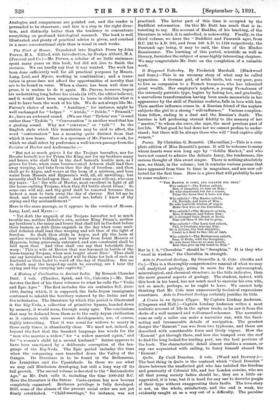A History of Civilisation in Ancient India. By Romesh Chunder
Dna. 3 vols. (Thacker, Spink, and Co., Calcutta )—Mr. Dutt devotes the first of his three volumes to what he calls the " Vedic and Epic Ages." The first includes the six centuries B.C. 2000- 1400, during which, it is supposed, the Indo-Aryan immigrants continued to inhabit the territory watered by the Indus and its five tributaries. The literature by which this period is illustrated is the Rig-Veda, a collection of primitive hymns, handed down by memory, it would seem, through many ages. The conclusions that may be deduced from them as to the early Aryan civilisation as it contrasts with more recent developments, are, of course, highly interesting. That it was usual for widows to marry in those early times, is abundantly clear. We need not, indeed, go beyond the fact that the Sanskrit language has words for the " man who marries a widow," for " a widow married again," and for a woman's child by a second husband." Suttee appears to have been sanctioned by a deliberate corruption of the lan- guage of the Rig-Veda. The Epic period includes the time when the conquering race travelled down the Valley of the Ganges. Its literature is to be found in the Brahmanas, the Aranyakas, and the Upanishads. In these we see what we may call Hindooism developing, but still a long way off its full growth. The second volume is devoted to the " Rationalistic Age," as Mr. Dutt calls it, including the time 1000-242 B.C. Here the literature is the Sutras. Caste-system has now become completely organised. Brahman privilege is fully developed. Still, some of the abuses of the present social order are not yet firmly established. " Child-marriage," for instance, was not practised. The latter part of this time is occupied by the Buddhist reformation. On this Mr. Dutt has much that is in- teresting to say. His account of Buddha, of his teaching, of the literature in which it is embodied, is noteworthy. Finally, in the volume, we have the " Buddhist and Pauranik ages, from B.C. 242 to A.D. 500, and from 500 A.D. to 1194 respectively, the Pauranik age being, it may be said, the time of the Hindoo Renaissance. The learning of this period, scientific as well as literary, furnishes the subject of some highly interesting chapters_ We may congratulate Mr. Dutt on the completion of a valuable work.


































 Previous page
Previous page